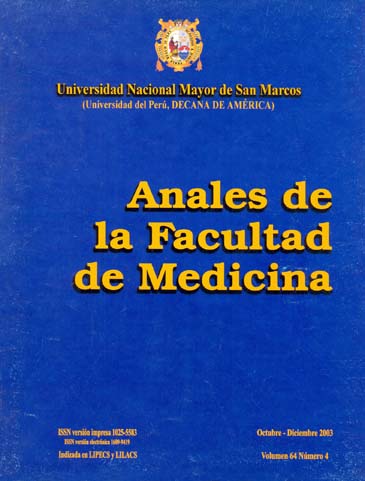Cystatin capture ELISA inmunodiagnosis of human fasciolosis at Chupaca-Junin province
DOI:
https://doi.org/10.15381/anales.v64i4.1428Keywords:
Fascioliasis, fasciola hepatica, enzyme-linked inmunosorbent assay, immunologic testsAbstract
Objective: To determine the prevalence of human fasciolosis in an endemic area by means of an enzyme-linked immunosorbent assay (ELISA) using cystatin as a capture agent for the detection of specific antibodies to Fasciola hepatica cysteine proteinases. Material and methods: An ELISA plate was sensitized with cystatin, incubated with excretory-secretory products of adult flukes, and followed by standard ELISA procedures. Clinical applicability of the cystatin capture ELISA for the immunodiagnosis of fasciolosis was tested with 200 serum samples of children and adults from an endemic area in Chupaca province, Junin department. Results: Serum samples from the endemic area tested by cystatin capture ELISA showed 27/ 200 (13,5%) of positive cases. Conclusions: Fasciolosis remains a major health problem at Chupaca province, Junin department.Downloads
Published
2003-12-31
Issue
Section
Contribución Corta
License
Copyright (c) 2003 WILLIAM CORNEJO, PILAR ALVA, CARLOS SEVILLA, ALINA HUIZA

This work is licensed under a Creative Commons Attribution-NonCommercial-ShareAlike 4.0 International License.
Those authors who have publications with this magazine accept the following terms:
- Authors will retain their copyrights and guarantee the journal the right of first publication of their work, which will be simultaneously subject to Creative Commons Attribution License that allows third parties to share the work as long as its author and its first publication this magazine are indicated.
- Authors may adopt other non-exclusive licensing agreements for the distribution of the version of the published work (eg, deposit it in an institutional electronic file or publish it in a monographic volume) provided that the initial publication in this magazine is indicated.
- Authors are allowed and recommended to disseminate their work over the Internet (eg: in institutional telematic archives or on their website) before and during the submission process, which It can produce interesting exchanges and increase quotes from the published work. (See El efecto del acceso abierto ).
How to Cite
1.
Cornejo W, Alva P, Sevilla C, Huiza A. Cystatin capture ELISA inmunodiagnosis of human fasciolosis at Chupaca-Junin province. An Fac med [Internet]. 2003 Dec. 31 [cited 2024 Jul. 17];64(4):252-4. Available from: https://revistasinvestigacion.unmsm.edu.pe/index.php/anales/article/view/1428















